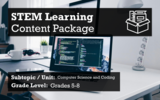
A single slide that defines the term algorithm and then lists the steps to bake a cake as an example
- Subject:
- Computer Science
- Technology
- Material Type:
- Lesson Plan
- Date Added:
- 12/01/2023

A single slide that defines the term algorithm and then lists the steps to bake a cake as an example

In this learning activity, students use a web-based carbon calculator to determine their carbon footprint on the basis of their personal and household habits and choices. Students identify which personal activities and household choices produce the most CO2 emissions, compare their carbon footprint to the U.S. and global averages, and identify lifestyle changes they can make to reduce their footprint.

Comparing the differences in the Y chromosomes in chimps and humans has created quite a buzz. [1:48]

Take a peek into the Academy's Center for Comparative Genomics with the lab's director, Brian Simison. Learn how cutting-edge technology is changing the way our scientists work.

Long after Gregor Mendel knew that something controlled heredity three other scientists finally put his research together with new evidence from microscopes to determine that genes do exist. This multimedia article includes animations, pictures, video, biographical information, and quiz questions that are accessed by clicking on buttons along the bottom of the page.

Homeobox genes are important because they determine the overall body plan for most animals. This article explains the experiments that helped scientists discover these master genes. Article includes animations, pictures, video, biographical information, and quiz questions that are accessed by clicking on buttons along the bottom of the page.

Learn more about what algorithms are and where we can find them in the world around us. [2:30]

Practice the steps of cloning in this interactive animation. Using what you know about somatic cell nuclear transfer, your mission is to create a genetically identical clone of Mimi, a brown female mouse. You'll answer a few questions at the end to show what you've learned.

This resource provides information about the careers in microbiology.

Watch how NJ high school students apply basic principles of molecular biology to solve real research probloms and publish their own genome research at GenBank, the international genomic sequence database. [6:12]

Computer science is a subject that is becoming more important to teach our students to prepare them for their future. Coding and having a basic understanding of different coding languages will be key for our students to feel truly ready for college or their career. Introducing students to these concepts can be a daunting task. This content package is created to try and alleviate some of those concerns. Within this content package for students in grades 5-8, educators will find lesson plans and activities that will help teach introductory computer science concepts. Educators will also find eBooks and digital texts to share with students, as well as videos to help guide students’ understanding of computer science.

A collection of topics to peak students interest for Science Fair projects.

Explore how birds use tools to hunt in this video. Watch New Caledonian crow use a stick to hunt for its food inside a log. [4:12]

A comprehensive collection of algorithm implementations for fundamental problems in combinatorial algorithms. Provides algorithms for common programming problems. It also provides pointers on how to implement those algorithms in various different languages

An algorithm is a method of solving problems both big and small. Though computers run algorithms constantly, humans can also solve problems with algorithms. David J. Malan explains how algorithms can be used in seemingly simple situations and also complex ones. [4:57]

You work at the college library. You're in the middle of a quiet afternoon when suddenly, a shipment of 1,280 books arrives. The books are in a straight line, but they're all out of order, and the automatic sorting system is broken. How can you sort the books quickly? Chand John shows how, shedding light on how algorithms help librarians and search engines speedily sort information. [4:37]

A video that shows the similarities and dissimilarities between human's and chimpanzee's DNA by examining the DNA sequence code. [2:14]

Learn the basics of an algorithm and it's use in computer programming. [5:27]
Khan Academy learning modules include a Community space where users can ask questions and seek help from community members. Educators should consult with their Technology administrators to determine the use of Khan Academy learning modules in their classroom. Please review materials from external sites before sharing with students.

Assessment templates, videos, examples, lesson plans, and photos of student work that directly address standard MS-LS4-5: artificial selection.